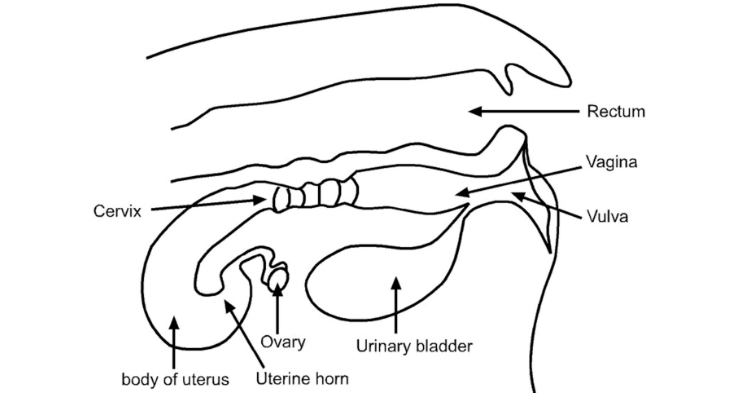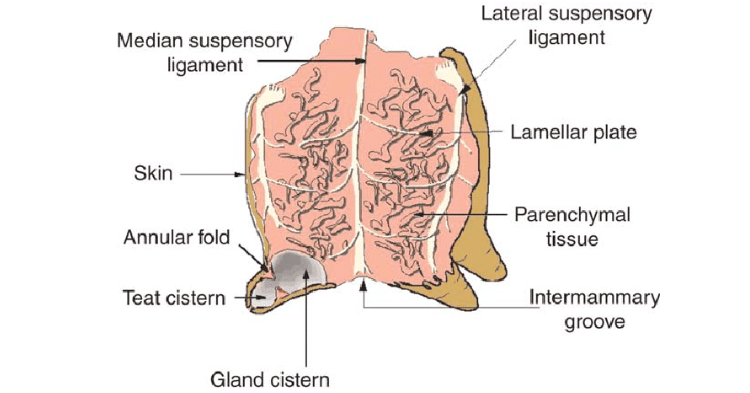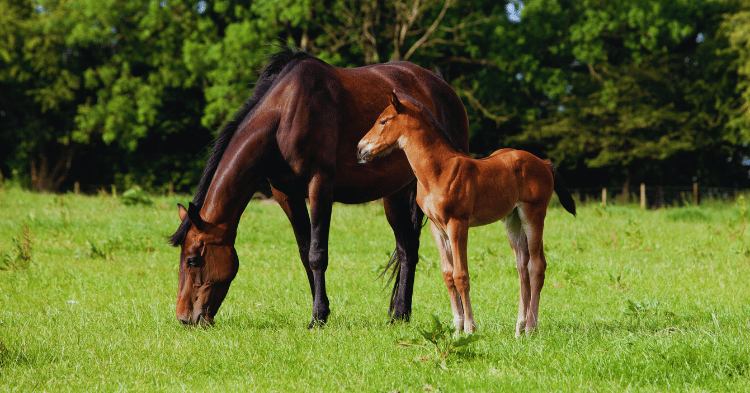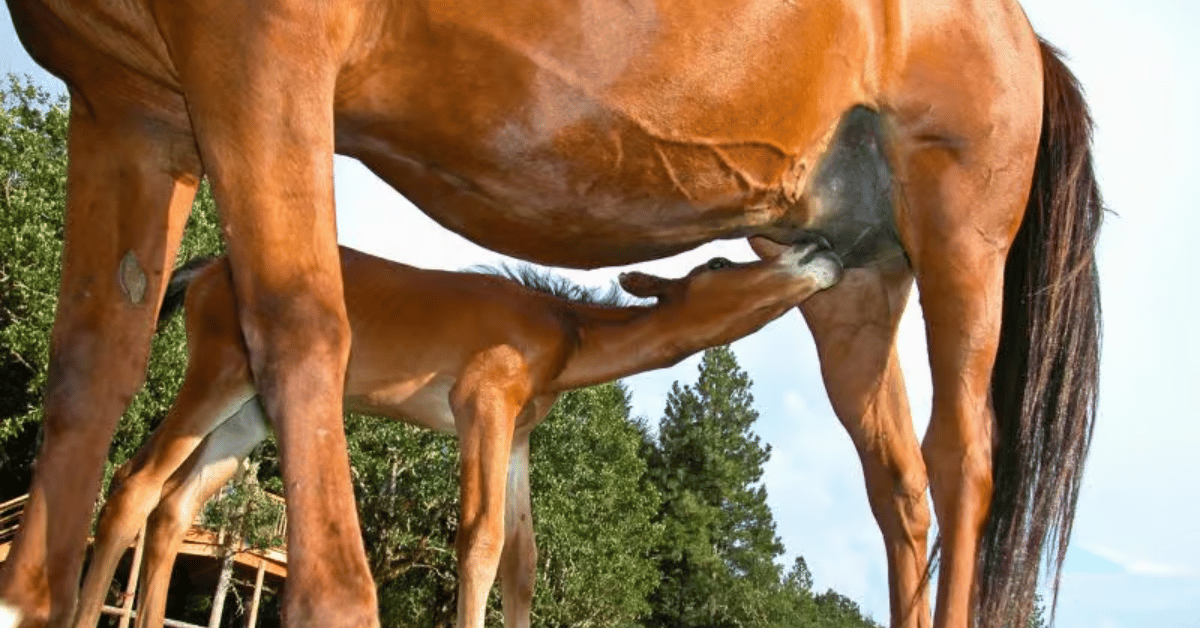When thinking about mammals and their anatomy, you might wonder, do horses have udders? The answer is yes—but only mares, or female horses, possess udders. Unlike cows, whose udders are prominent and designed to produce large quantities of milk, a mare’s udders are much smaller and less noticeable, nestled between their hind legs.
A mare’s udders consist of two teats, each with its own milk duct. They play a vital role during the early stages of a foal’s life, producing nutrient-rich milk that supports the foal’s rapid growth.
However, outside of lactation, the udders remain dormant and typically require little attention unless there’s an issue, such as swelling or infection. Understanding this part of equine anatomy can help horse owners ensure proper care, especially during breeding and foaling seasons.
Understanding Horse Anatomy
When exploring the anatomy of horses, it is essential to understand their reproductive organs and how they differ from other mammals. This knowledge can provide insights into common questions, such as “do horses have udders?”

Reproductive Organs of Horses
Horses, like other mammals, possess distinct reproductive organs based on their sex. In mares (female horses), the primary reproductive organs include the ovaries, fallopian tubes, uterus, and vagina. The ovaries are responsible for producing eggs and releasing hormones essential for reproduction. The fallopian tubes transport the eggs from the ovaries to the uterus, where fertilization and early development of the embryo occur. The vagina serves as the birth canal during foaling.
Stallions (male horses) have reproductive organs including the testes, epididymis, vas deferens, and penis. The testes produce sperm and testosterone, a hormone crucial for male reproductive functions. The epididymis stores and matures sperm before it travels through the vas deferens to be ejaculated through the penis during mating.
Differences from Other Mammals
While horses share some anatomical similarities with other mammals, there are notable differences, particularly concerning lactation and udders. Unlike cows or goats, which have pronounced udders consisting of mammary glands and multiple teats, horses have a less visible lactation system.
In cows, buffalo, sheep, and goats, udders consist of pairs of mammary glands grouped into a single mass, typically with one or more teats per gland (Wikipedia). Each mammary gland is a specialized structure designed for milk production and suckling.
Mares have two mammary glands, each with one teat, located between their hind legs. These mammary glands produce milk to nourish their foals. Unlike the prominent udders seen in dairy cows, the mammary glands in mares are smaller and less conspicuous. The structure and function of mammary glands in horses align them more closely with other eutherian mammals, where mammary functions are typically present only in females.
Understanding the similarities and differences in mammary structures can clarify why the visible udder structure seen in cows is not present in horses. To learn more about specific horse-related topics, such as “do horses have fur” or “can horses eat apples“, feel free to explore our internal links.
| Feature | Horses | Cows |
|---|---|---|
| Number of Mammary Glands | 2 | 2 pairs (total 4) |
| Number of Teats | 1 teat per gland (total 2) | 1 teat per gland (total 4) |
| Udder Visibility | Less visible | Highly pronounced |
Understanding these anatomical and functional differences helps in addressing myths and questions such as “do horses have udders?” For more information on related topics, you can visit articles like do horses drink milk and do horses sleep standing up.
Udders in Mammals

In understanding the anatomy and functions of udders among various mammals, it’s essential to note their primary roles and unique characteristics in comparison to other species.
Function of Udders
Udders are specialized organs present in many female mammals and are responsible for the production and secretion of milk for their offspring. These organs contain mammary glands which produce milk through a process called lactation. The mammary glands are a defining feature of mammals, including their lactation capability (CK-12).
Lactation ensures that newborns receive the necessary nutrients and antibodies to grow and develop. In most mammals, lactation occurs in females who have recently given birth, although there are rare instances of male lactation in few species, including humans.
| Mammal Type | Presence of Nipples/Mammary Glands | Lactation Capability |
|---|---|---|
| Prototherians (e.g., platypus) | No Nipples | Both Males and Females |
| Metatherians (e.g., kangaroo) | Yes, in Females | Females Only |
| Eutherians (e.g., humans, horses) | Yes, in Females | Females Only |
Unique Characteristics in Mammals
Udders and mammary glands vary significantly among different mammalian species, each adapted to the specific needs of the offspring and the environment in which they live. For instance, monotremes like the platypus and echidnas lack nipples entirely. Instead, their mammary glands secrete milk that drips out onto tufts of fur, which the young lick for nourishment (Slate).
In prototherian mammals, both males and females have functional mammary glands, a trait not observed in the majority of metatherian and eutherian mammals (Wikipedia). Most metatherian and eutherian species, including horses, have functional mammary glands only in females, designed to cater to the nutritional needs of their offspring.
Despite the common belief, horses do not have udders like cows. Instead, they possess mammary glands that are specifically structured to support their own lactation process (BBC Earth). This structural difference exemplifies the diversity in mammalian lactation and reproductive anatomy.
Exploring these distinctions highlights the fascinating variability among mammals’ reproductive and lactational capabilities, emphasizing the uniqueness of each species. For more questions regarding horse anatomy and other intriguing facts, explore our articles on common topics like do horse produce milk and can horse sweat.
Lactation in Horses

Despite common misconceptions, horses do not have udders. Instead, mares possess mammary glands through which they produce milk to nourish their offspring. Here, we will explore milk production in mares and the duration of their lactation period.
Milk Production in Mares
Mares begin to produce milk shortly before giving birth and continue lactating for several months post-birth. Equine milk has a unique composition that is tailored to the needs of foals. It contains more crude protein than human milk but less than bovine milk. Mare’s milk also has relatively low energy content due to limited fat and carbohydrate levels. Consequently, foals receive over half of their daily caloric intake from lactose through frequent suckling.
Mares can be milked in various ways, including by hand, commercial milkers, or even a syringe. An average lactating mare produces between 500 milliliters to 1 liter of milk every two hours (The Horse).
| Method | Milk Production (every 2 hours) |
|---|---|
| Hand Milking | 500 ml – 1 liter |
| Commercial Milker | 500 ml – 1 liter |
| Syringe | 500 ml – 1 liter |
Duration of Lactation
Lactation in horses corresponds to approximately 25% to 50% of their 11-month gestation period. Typically, mares lactate for 3 to 6 months postpartum. In some cases, especially in the wild, mares may continue to lactate for over a year (PubMed Central).
| Lactation Period | Duration |
|---|---|
| Domestic Mares | 3 – 6 months |
| Wild Mares | Up to 1 year |
Understanding the lactation process in mares is vital for horse owners. By ensuring mares have proper nutrition and care during this period, owners can help maintain healthy milk production for foals. For more intriguing facts about horses, such as can horse see color or can horses cry, delve into our other articles.
Milking Practices
Understanding effective milking practices for mares is crucial for horse owners interested in milk production from their horses. Below are the methods of milking mares and the importance of milk let-down.
Methods of Milking Mares
Milking a mare can be done using two primary methods: hand-milking and mechanical milking. Each method has its own set of practices and considerations.
Hand-Milking
Hand-milking is often challenging, especially if the mare is uncooperative or experiencing udder issues like edema. Key steps include:
- Clean Hands: Always ensure hands are clean to prevent mastitis, a low-frequency but serious issue in mares (PubMed Central).
- Gentle Technique: Be gentle to stimulate milk flow and avoid discomfort for the mare.
- Complete Emptying: It’s crucial to empty both openings in the teat completely to prevent any blockages.
- Frequency: Mares should be milked every two hours to maintain production and prevent issues.
Mechanical Milking
Mechanical milking involves specialized equipment, which may be more efficient but requires an initial investment. This method is less common and often used in clinical or controlled farm environments.
A comparison of the two methods:
| Milking Method | Pros | Cons |
|---|---|---|
| Hand-Milking | Cost-effective, immediate | Labor-intensive, challenging |
| Mechanical Milking | Efficient, less labor-intensive | High initial cost |
Importance of Milk Let-Down
Milk let-down is the process by which the mare releases milk from her udder. Successful let-down is essential for effective milking. Several factors and practices can help encourage milk let-down:
- Adequate Feeding: Ensure the mare is well-fed to support milk production.
- Foal Interaction: Allowing the mare to nuzzle her foal can stimulate natural let-down.
- Warm Compress: Applying a warm compress to the udder can aid in relaxation and milk flow.
- Oxytocin Administration: In some cases, administering oxytocin can promote let-down, though this should be done under veterinary guidance.
For optimal milk let-down, it’s essential to maintain a stress-free environment for the mare. Gentle handling and consistent routines also play significant roles in encouraging milk production.
For additional information on horse care and practices, you can explore our articles on can horse sleep standing up, can horses throw up, and expedition on horse grooming.
Understanding the right methods and conditions for milking mares can significantly impact both the health of the mare and the quality of milk produced. Always prioritize the well-being of your horse in these practices.

